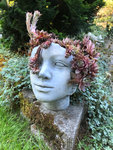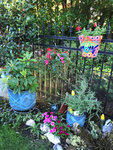

Potted geraniums on a front porch are a pleasant greeting when you come home from work, and a visual treat for neighbors walking by.
But plants in pots are more than a pleasantry. For people who garden on decks, patios or balconies, and for those who have a hard time kneeling and bending, gardening in pots is a necessity.
It’s a happy necessity though, because plants in pots make artists of their owners. The choice of pots, the combination of plants, and the way they are grouped offer endless choices and a constant learning curve about color, composition, proportion, and cultural requirements.
Plants in pots can also perform what scientists call “ecosystem services.” A friend has two Northwest native ninebark shrubs planted in big pots on her deck that screen it from the street during all the months of the year when the deck is in use.
Another friend with an already large and glorious garden has a zillion pots on her deck and her patio, and waist-high planters along the east and south sides of her house. She has so many potted plants she’s had a watering system installed for them.
I used to be skeptical about plants in pots. One day downtown I saw planters on either side of a business entrance with baby western red cedars in them, and it made me sad. Those poor little cedars, I thought; they really wanted to grow up to be magnificent, enormous trees. Confinement to pots would spell their doom within a couple of years, if they survived that long. I briefly thought about starting an anti-pot Plant Liberation Movement.
Then I remembered bonsai, the art of purposely preventing plants from reaching their normal size by growing them in pots and pruning them to be miniature versions of themselves. To each her own, I said to myself. Maybe those cedars are somebody’s art project.
So just in case you’ve thought about the art of plants in pots, here are some basics:
Auntie Google has endless advice about growing plants in pots, and YouTube does too. It’s entertaining to see how wildly various sites and videos contradict each other, but worth spending half an hour clicking around just to collect ideas. In no time at all, you’ll become a master of potted plants, and possibly the next YouTube star.
Jill Severn writes from her home in Olympia, where she grows vegetables, flowers and a small flock of chickens. She loves conversation among gardeners. Start one by emailing her at jill@theJOLTnews.com
Comments
No comments on this item Please log in to comment by clicking here